Swiss alpine summer farming: current status and future development under climate change
Felix Herzog A C and Irmi Seidl BA Agroscope, Reckenholzstr. 191, CH-8046 Zurich, Switzerland.
B WSL (Swiss Federal Research Institute for Forest, Snow and Landscape), Zürcherstr. 111, CH-8903 Birmensdorf, Switzerland.
C Corresponding author. Email: felix.herzog@agroscope.admin.ch
The Rangeland Journal 40(5) 501-511 https://doi.org/10.1071/RJ18031
Submitted: 14 March 2018 Accepted: 4 July 2018 Published: 23 July 2018
Journal compilation © Australian Rangeland Society 2018 Open Access CC BY-NC-ND
Abstract
High altitude grazing is widespread around the globe and also has a long tradition in European mountain regions. One-third of the Swiss farmland consists of summer pastures: seasonally used marginal pastures without permanent settlements, which extend between the grasslands and forests of permanent mountain settlements and unproductive mountain tops. Farmers’ main motivations for using those pastures have been and still are forage provision and health benefits for grazing animals, benefits for labour distribution between home farm and summer farm, and cultural ecosystem services such as the maintenance of a tradition and the associated lifestyle. Yet, remote pastures are being abandoned and are prone to reforestation, while more productive and accessible pastures are intensified. Those processes are related to changes in management practices, to scarcity of labour and – to a lesser extent – to climate change. We summarise the agronomic and ecological status of Swiss summer pastures, in particular with respect to livestock keeping, biodiversity and climate change, and speculate on future trends of summer farming.
Additional keywords: biodiversity, farmers’ perception, marginal grassland, rangeland, rough grazing, seasonal grazing, transhumance.
Introduction
High altitude grasslands in mountain regions are often grazed only seasonally. Herders move up to these regions with their animals during the favourable season – usually the summer – to use the forage that is available for a short period of the year. Such so-called vertical transhumance systems are common across all major mountain regions in the world (Suttie and Reynolds 2003; Bunce et al. 2004). In western, central, southern and northern Europe, more than four million hectares of grasslands are used through transhumance (Herzog et al. 2005). These are mostly located across the Alpine Arc and the Massif Central, the Carpathians, the Apennines, the Balkan and Greek mountains and the Pyrenees. In the boreal zones, such as in Norway, transhumance also occurs in mountains with lower elevation (Austad et al. 2004).
Transhumance links lowland and highland habitats. Together, they form two components of an integral system. Seasonally grazed mountain grasslands are among Europe’s most prominent High Nature Value farming systems (Oppermann et al. 2012). Like many High Nature Value farming systems, however, seasonal mountain grazing is torn between abandonment and intensification. In the Atlantic mountains of the British Isles, for example, the tradition of seasonal grazing with migrating herds ceased 150 years ago (Jones and Wmffre 2004). Extensive mountain farming systems – like many rangeland systems – are threatened because they are relatively labour intensive but otherwise low input and low yielding, compared with other farming systems. Industrialisation of agriculture and globalisation require large quantities of standardised agricultural products, while seasonal summer farming yields smaller quantities of products with differing properties (e.g. cheeses of different types, consistency, taste, etc.). Still, they are often high-quality traditional specialties, linked to their geographical origin with, for example, a PDO (Product of Designated Origin) label. Also, many summer farming regions are, at the same time, attractive tourist destinations (Herzog and Schüepp 2013).
In Switzerland, the contrast between an industrialised society with a modern farming sector and the traditional summer mountain grazing practices is particularly striking. From most Swiss lowland cities, it takes less than 2 h to reach the summer farming region, where traditional, extensive herding is still practiced. In fact, 11% of the Swiss national territory (and one-third of its farmland) consists of summer pastures in the Alps and the Jura mountains. Despite their importance at the national scale for the farming sector, for mountain landscapes and related ecosystem services (e.g. biodiversity, soil protection), up-to date information on summer farming practices is limited. Research and land use statistics of the last decade reveal that the abandonment of summer pastures is ongoing (Baur et al. 2007). At the same time, grassland utilisation tends to be intensified at locations, even within the mountain zone, where the natural conditions are favourable, and which farmers can easily reach with their herds (Kampmann et al. 2008). The most recent national evaluation was collated by Werthemann and Imboden (1982), based mainly on inventory data recorded from the 1950s onwards. There was thus uncertainty about the current situation of summer farming in Switzerland, and there were conflicting visions about its future development and the attitudes of stakeholders and policymakers towards it. We therefore initiated a national research program entitled, ‘AlpFUTUR – The future of Swiss summer pastures’ (Baur et al. 2007; Seidl et al. 2015; www.alpfutur.ch). In all, 80 researchers conducted 22 individual projects, which addressed agronomic, environmental, socioeconomic and technical issues related to summer farming (Lauber et al. 2013). This article summarises the agronomic and ecological findings of the AlpFUTUR program, whereas Seidl and Böni (I. Seidl, R. Böni, unpubl.) look at societal implications of summer farming and Schulz et al. (2018) present the implications for economic viability and government support.
Status of summer farming in Switzerland
About 7100 summer farmers manage 465 000 ha, grazed by 700 000 animals (mostly cattle and sheep), which correspond to 290 000 livestock units. In most locations, the summer grazing season lasts on average for ~100 days between mid-June and end of August. Summer pastures are an only seasonally used belt of marginal pastures without permanent settlements, extending between the grasslands and forests managed from permanent mountain settlements and the mountain tops consisting of mostly rock and ice (Figs 1 and 2). Since the Middle Ages, significant amounts of forest have been cleared and converted to rangelands and, as a consequence, in many regions the actual tree line is several hundred meters below the potential upper limit of forest growth (Szerencsits 2012).
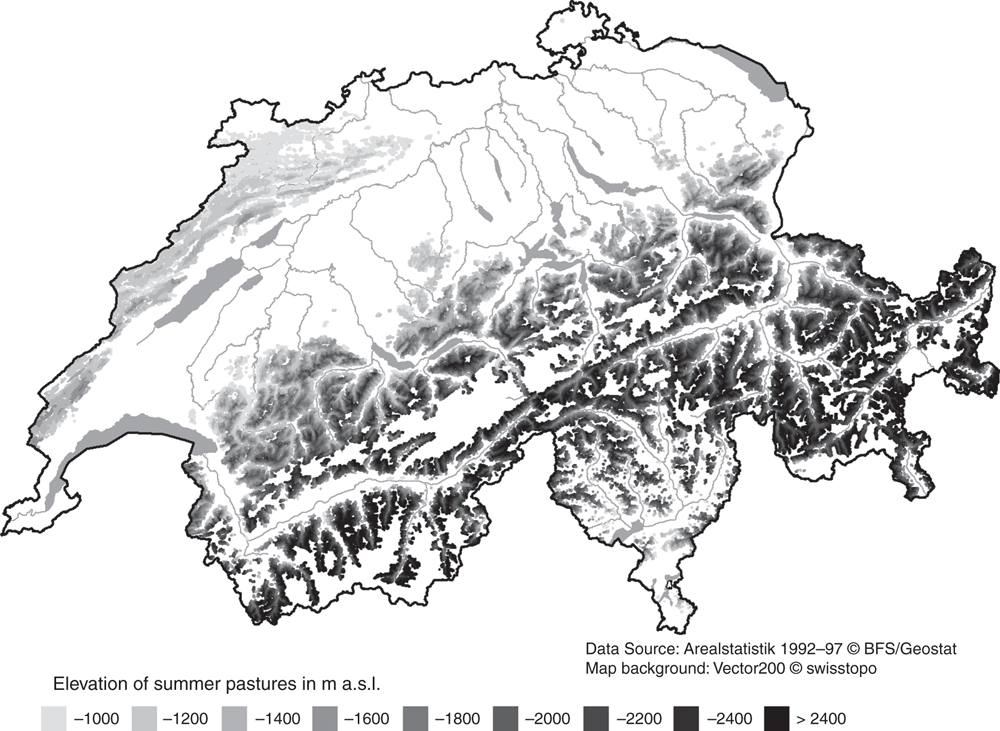
|
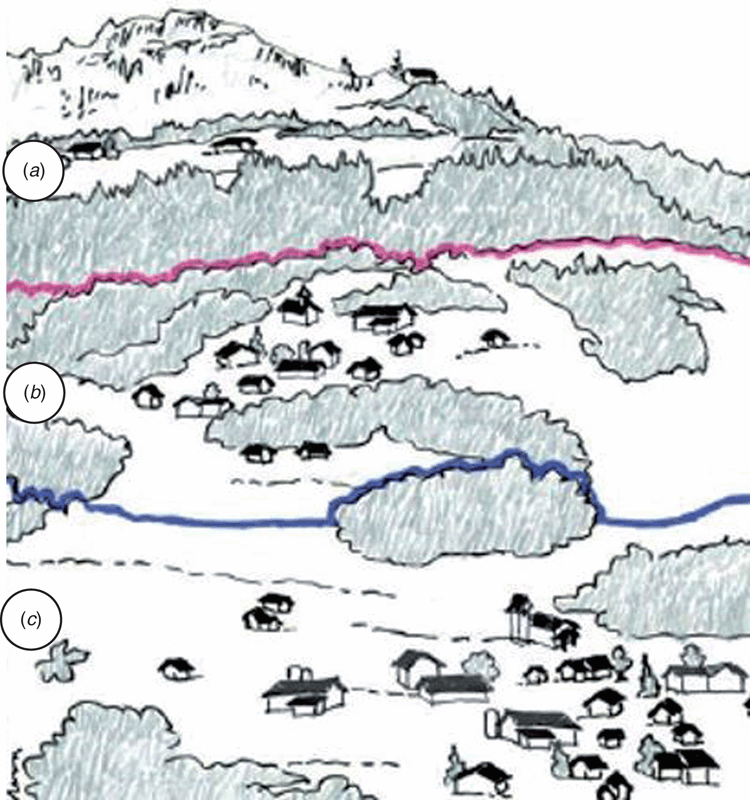
|
Farmers started to use the summer pastures because the additional forage they provide allowed armers to increase the size of their herds. This is still their most important motivation today, together with observed positive effects on animal health such as fertility and general fitness (Fig. 3). The third most important argument concerns the organisation of labour during the summer season. When employed herders or family members take care of the animals on the summer farms, the workload on the home farm is reduced and labour is freed for making hay and silage. Farmers also value the pleasure that they gain from staying and working in the alpine environment and the tradition of summer farming as such. Additional arguments (not shown in Fig. 3) are concerned with the profitability (including subsidies) and the actual products obtained during the summering season (see Schulz et al. 2018).

|
Major agronomic and ecological challenges
Abandonment, intensification and biodiversity
Mountain grasslands worldwide are known to be particularly rich in species (Klötzli et al. 2010; Spehn et al. 2010). They host specific plants and animals that are adapted to the often harsh environmental conditions; therefore, mountain grasslands are among the biodiversity hotspots of the world (Fischer et al. 2008; Peter et al. 2009). This is also true for the Swiss summer pastures, on which three-quarters of the country’s protected wetlands and dry meadows of national importance are located. Besides hosting 250 vascular plant species for which Switzerland has a specific responsibility, summer pastures host eight of the country’s 12 endemic vascular plant species (Lauber et al. 2013). At the landscape scale, the different characteristic grassland habitats that are laid out in the variable mountain topography and are interspersed with forest islets, form a characteristic and attractive landscape, which is a major asset of the national tourist industry.
However, those areas are threatened by both abandonment and intensification. Abandonment of marginal grassland has occurred in most European mountain regions over the last decades (e.g. Pornaro et al. 2013). In Switzerland, regional policy and the financial support to agriculture through agri-environmental schemes have slowed this trend and contributed to maintaining traditional farming practices (Kampmann et al. 2012). Nevertheless, ~2400 ha of summer pastures are invaded by forest every year (Brändli 2012), amounting to a loss of almost 30 000 ha over the last 25 years (BFS 2013). Based on a spatially explicit model by Rutherford et al. (2008), we projected the future trend and evaluated its implications for species diversity (Schüpbach et al. 2012). The model predicts that abandonment and afforestation will be highest in the southern and central Alps (Fig. 4). The south-eastern Alps, in particular, have the highest importance for plant and animal species that depend on traditional, extensive summer pasturing (Walter et al. 2010).
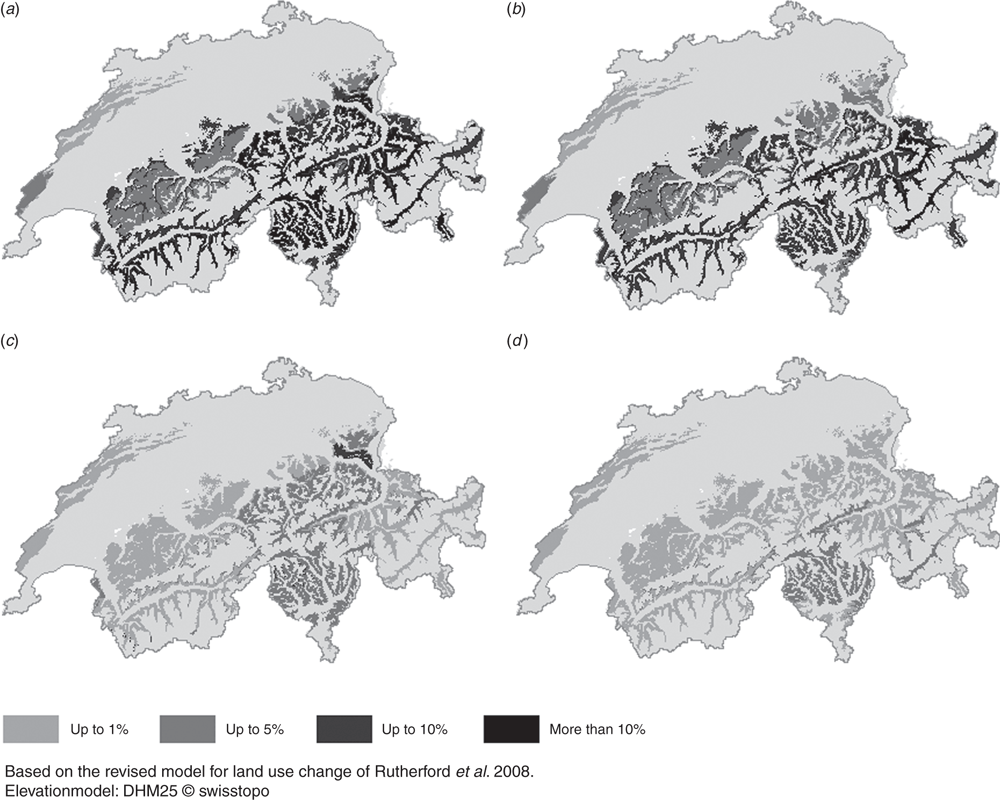
|
A detailed analysis of two specific summer pastures, however, revealed that increased habitat heterogeneity because of shrub encroachment increased the number of species and the ecological quality of the pastures (Koch et al. 2015). Fig. 5 illustrates that the number of vascular plants is highest on summer pastures that are overgrown by 50% of Juniperus communis. Homburger et al. (2013) have also found the highest numbers of vascular plants on summer pastures grazed at medium levels of intensity. Those findings support the intermediate disturbance hypothesis (Horn 1975); similar curves have also been observed in European and American mountain grasslands (Cingolani et al. 2003; Spiegelberger et al. 2006; Olofsson and Shams 2007; see also Stohlgren et al. 1999). Higher numbers of species of vascular plants were consistent with higher arthropod diversity (grasshoppers, butterflies; Koch et al. 2013a). At yet higher levels of shrub cover, however, biodiversity declined, the spectrum of species changed and the species typical of summer pastures disappeared (Koch et al. 2015). Keeping the shrub cover low on marginal rangelands has always been a challenge. It requires careful herding management to maintain a certain grazing pressure (see also Babái et al. 2014; with an example from the Carpathians). In most cases, manual or mechanical removal of shrubs is also required. Keeping up this active maintenance of summer pastures has become more difficult during the last decades. The main reasons are that, in Switzerland, labour has become more expensive and the structural change in agriculture has led to bigger home farms managed by fewer people: the number of mountain home farms has decreased by 50% since the 1980s (BFS 2016). Both the trend and its origins are observed throughout European mountain regions (see MacDonald et al. 2000; and references therein). During summer, farm families are busy working the more fertile farmland and little time is left for maintaining remote, marginal rangelands. Among the summer pastures, farmers tend to intensify – if feasible – the more productive and easily accessible sections. This also entails a decrease in biodiversity. In order to counteract both trends – abandonment and intensification – a result-oriented agri-environmental scheme has recently been introduced. It grants payments for those sections of the summer pastures that maintain a minimum number of target plant species (Bundesrat 2016; see Schulz et al. 2018).
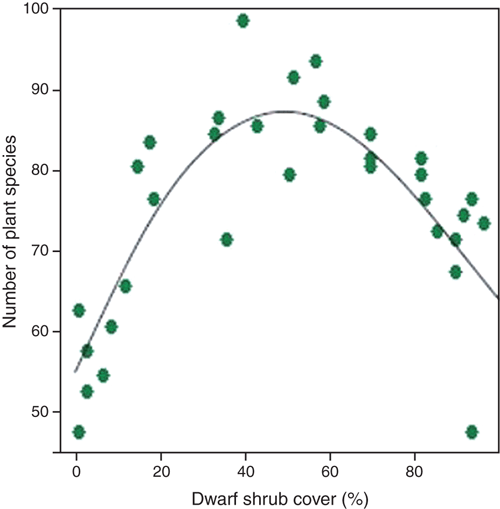
|
Livestock keeping: intensity and feeding strategy
One reason for the loss of pastureland is the slight but continuous decrease in summering animals over the last decades (Baur et al. 2007). In particular, the number of milk cows and heifers has been reduced, and suckler cows have only partly replaced them. Among other factors, this can be explained by the increased performance of modern cow breeds. In fact, high-yielding dairy cows require more energy intake at higher altitudes (Christen 1992; Imfeld-Müller 2013) and therefore suffer on summer farms from an energy deficit, which leads to reduced milk yield at the beginning of the summering season. Attempts to compensate for this deficit with cereal and protein supplements have been only partially successful. On an alpine pasture in Italy (1900 m a.s.l.), Bovolenta et al. (2009) supplemented the cow diet with 4.8 kg of organic matter per day, resulting in an increase in milk yield of only 0.9 kg day–1. The supplements actually reduce the intake of grass and the net energy intake is increased only at higher levels of supplementation (Berry 2000). On Swiss alpine pastures, supplements are regulated and limited to 1 kg day–1 per milk cow, mainly to limit nutrient imports to elevated mountain grasslands. High-yielding milk cows are less suitable for grazing steep and remote summer pastures, as already observed by Bovolenta et al. (1998), and often remain in the valley throughout the year. Farmers who pursue a strategy of intensification and high levels of milk production lose interest in the tradition of summer farming.
Other farmers, however, consider such a strategy as risky, and instead maintain a medium intensity level of production. They also strive for diversification, sometimes with combinations of economic activities from outside the farming sector (e.g. part-time jobs in the tourist, building or forest industry). Usually, such farmers keep medium performing livestock and which are more suitable for summer farming, which has been shown to be beneficial for animal health and to increase cow fertility, such that (un-productive) periods between lactations remain short. Although heifers and fattening stock may gain less weight during the summering season, they exhibit compensatory growth once back in the valley (see also Bohman’s 1955; experiment with different qualities of hay). Breeding cattle that had spent a summer period on alpine pastures had a higher milk yield during the first lactation compared with cattle that had remained on the valley farm (Imfeld-Müller 2013). Expected health benefits are among the most important reasons why farmers send their animals to summer pastures (Fig. 3).
Livestock keeping: grazing management strategies
Summer pastures are often rather large rangelands where the animals are free to move during the grazing period. Homburger et al. (2014, 2015) have shown that the utilisation of those grasslands can be quite heterogeneous, with some parts being intensively grazed while other parts are almost abandoned. This effect is often particularly observed on summer farms with sheep because sheep tend to aggregate at the upper parts of the summer pasture. These parts are then overgrazed, whereas the lower parts are hardly grazed. Rotational pastures and active herding allow for a better control of the grazing animals and of the quality of the pastureland (Table 1). Those systems, however, are more labour intensive and profitable only for larger herds (Schulz et al. 2018).

|
In recent years, new categories of animals have made their appearance on Swiss summer farms. Suckler cows are the most important of those new animal categories, but also oxen, donkeys, llama, alpaca and even geese are summered. Different animal categories have different effects on the vegetation, on account of their specific grazing behaviour, weight, etc. (Schneider et al. 2013). Loucougaray et al. (2004) recommend a combination of different animal categories in order to improve the rangeland management and to facilitate the maintenance of forage quality of the sward. In fact, combinations of goats and milk cows as well as of horses and cattle are successfully practised on various summer pastures and are even characteristic for some regions such as the Jura Mountains with free-ranging horses and cattle (Imfeld-Müller 2013). Additional combinations should also be tested in field experiments.
Climate change
Recent predictions for climate change in the Alpine Arc indicate that, by 2050, average temperature will rise by up to 2°C and precipitation will decrease, particularly during the summer months (CH2011 2011; Zubler et al. 2014). The magnitude of those effects, however, varies strongly between regions and valleys. In order to obtain a more differentiated picture of the consequences of climate change, we interviewed experienced practitioners and agricultural extension agents from major regions in the Alps and the Jura mountains. We opted for a qualitative approach, in contrast to survey techniques (e.g. Nunoo and Akua Asiamah Nunoo 2016). We asked them whether they had perceived climatic trends over the last decades, what the consequences for summer farming were until now and what they possibly expected for the future. Their responses are summarised in Table 2.
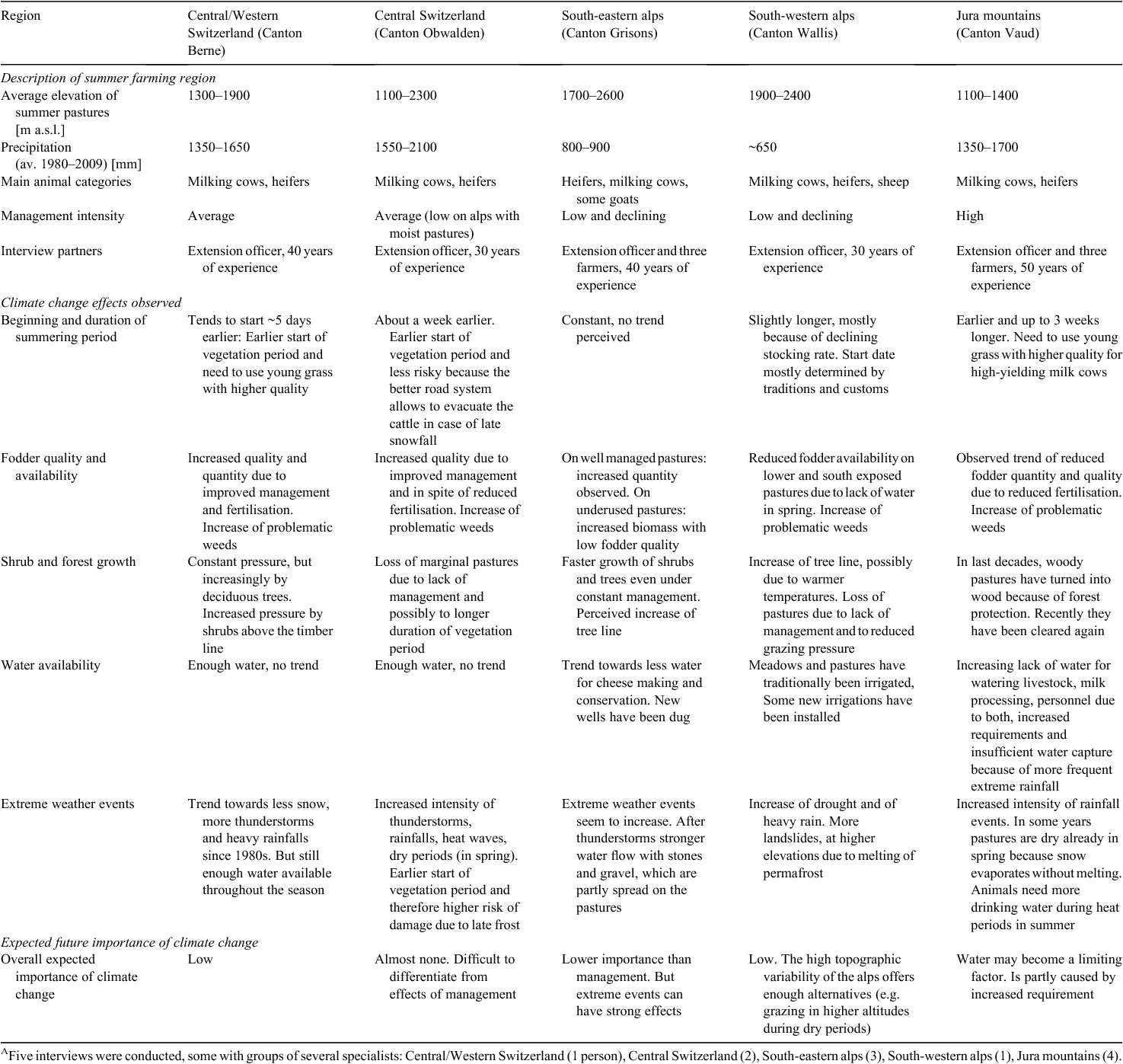
|
It is evident that the results of such qualitative interviews have to be interpreted with caution. The farmers and extension officers themselves underlined that their evaluations may be affected by subjective perceptions. Yet, their responses are fairly consistent and can be summarised as follows:
-
Over the last decades, the summer farming season has started earlier in the spring (by about a week). It also tends to last longer, but its duration is limited by the availability of forage.
-
The overall productivity of summer pastures has increased, allowing for longer and/or more intensive pasturing. This can be due to both climate change and agronomic measures (fertilisation with organic manure, improved pasture management), and the effects of changing climate and land-use practices cannot be disentangled.
-
Shrubs and trees also seem to grow more vigorously and the encroachment of marginal summer pastures by woody species appears to happen more rapidly.
-
Water scarcity during the summering period has always been a limiting factor in the Jura Mountains and in the south-western and south-eastern Alps. In those regions, water scarcity has worsened during the last decades. Effects of water scarcity vary strongly at the small scale and depend on local elevation and exposition. This offers the opportunity to move animals from drier pastures to pastures where forage is still growing. Pipelines are being built to transport water to summer farms that regularly suffer from lack of water.
Some of those observations are confirmed by measured time series such as the decrease in snowfall since the 1980s (Laternser and Schneebeli 2003), earlier start of the vegetation period along with higher biomass production (OcCC 2007; Jonas et al. 2008; Rammig et al. 2010), a trend for the tree line to shift to higher altitudes (Gehrig-Fasel et al. 2007) and longer dry periods in the Jura mountains (Buttler et al. 2012).
At the large (regional) scale, summer pastures may become more important in years when forage growth is inhibited in the lowlands because of summer dryness. Grazing animals may then be moved to higher altitudes, including summer pastures, where there is still comparatively higher precipitation and more forage available. More flexible stocking strategies are recommended and observed as a strategy to adapt to climate change also in North America and South Africa (e.g. Derner et al. 2016; Samuels et al. 2016).
Conclusions and recommendations
Table 3 proposes a conceptual approach to factors that favour either intensification or extensification/abandonment of summer farming in Switzerland. Yet, summer farming is a tradition that farmers and policymakers want to maintain, despite its dependence on public support through subsidies. The major justification for those subsidies are the ecosystem services they help maintaining, namely the production of forage, biodiversity, landscape scenery and cultural values. Specific agri-environmental schemes targeting those services have recently been put in place by the government, in line with the recommendation resulting from the AlpFUTUR program (Schulz et al. 2018). Payments for summer-pasture biodiversity are result-oriented, which should increase the motivation of summer farmers to maintain species-rich pastures. To this end, shrub encroachment and reforestation need to be controlled by combinations of manual labour and careful and targeted pasture management, which may also involve combinations of different animal species (Koch et al. 2013b). Best management practices are illustrated by three short AlpFUTUR films, in which summer farmers explain their herding strategies (Fry 2013; Herzog et al. 2016). Deliberate abandonment of remote or particularly steep or exposed sections, possibly even with targeted reforestation, will reduce the workload for summer farmers and may also reduce injuries and losses of grazing animals at sometimes hazardous locations.
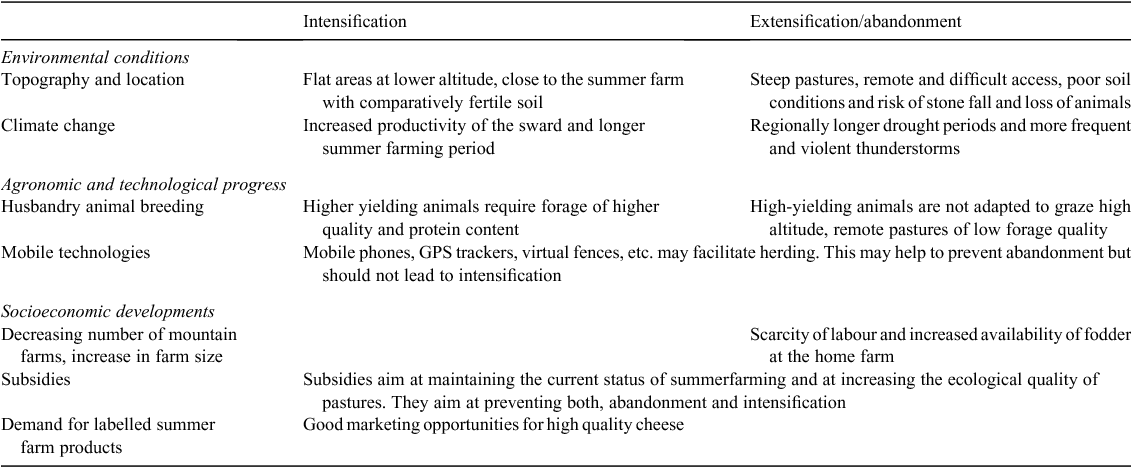
|
Under climate change, forage production even on marginal summer pastures may gain importance. Although they will also be affected by reduced summer precipitation and higher temperatures, effects are expected to be less at high elevations compared with the lowlands. Because the topography is highly variable, many summer farms have pastures with differing exposures, and north-exposed pastures will be less affected by summer drought. This may lead to a renewed reliance of farmers on mountain summer pastures for forage production.
Conflicts of interest
The authors declare no conflicts of interest.
Acknowledgements
We want to thank the numerous herders, farmers, extension officers, administrators and policymakers who were involved in the AlpFUTUR research process. We are grateful to the sponsors who provided the research funds needed. And we particularly acknowledge the contributions of the many researchers and students who contributed to the AlpFUTUR program with a lot of dedication. Please refer to www.alpfutur.ch for a detailed list of persons and institutions that were involved. We acknowledge the advice of two anonymous reviewers and of the editors, whose comments helped to improve an earlier version of the manuscript.
References
Austad, I., Norderhaug, A., Hauge, L., and Moen, A. (2004). An overview of Norwegian summer farming. In: ‘Transhumance and Biodiversity in European Mountains’. IALE Publication Series No. 1. (Eds R. G. H. Bunce, M. Pérez-Soba, R. H. G. Jongman, A. Gómez Sal, F. Herzog and I. Austad.) pp. 7–18. (Alterra and IALE: Wageningen, The Netherlands.)Babái, D., Molnár, Á., and Molnár, Z. (2014). Ahogy gondozza, úgy veszi hasznát” Hagyományos ökológiai tudás és gazdálkodás Gyimesben. Traditional ecological knowledge and land use in Gyimes (Eastern Carpathians). Budapest, Vácrátót. 175 pp. (MTA Bölcsésztudományi Kutatóközpont Néprajztudományi Intézet és MTA Ökológiai Kutatóközpont Ökológiai és Botanikai Intézet.)
Baur, P., Müller, P., and Herzog, F. (2007). Alpweiden im Wandel. Agrarforschung 14, 254–259.
Berry, N. R. (2000). Production efficiency and nutrient cycling of Brown Swiss dairy and Scottish Highland sucklers on high altitude pastures under varied feeding conditions. Dissertation, Eidgenössische Technische Hochschule (ETH), Zürich, Switzerland.
BFS (2016). ‘Landwirtschaftliche Betriebszählung.’ (BSF (Bundesamt für Statistik/Office Fédéral de la Statistique): Neuchâtel.)
BFS (Swiss Federal Office for Statistics) (2013). Die Bodennutzung in der Schweiz. Statistik der Schweiz 002–0901, BSF, Neuchâtel.
Blanke, V., and Herzog, F. (2012). Klimawandel, Nutzungswandel und Alpwirtschaft. Schlussbericht des AlpFUTUR-Teilprojektes 4 ‘Klima’. Available at: http://www.alpfutur.ch/src/2012_klima_teil1.pdf (accessed 8 June 2018).
Bohman, V. R. (1955). Compensatory growth of beef cattle: the effect of hay maturity. Journal of Animal Science 14, 249–255.
| Compensatory growth of beef cattle: the effect of hay maturity.Crossref | GoogleScholarGoogle Scholar |
Bovolenta, S., Ventura, W., Piasentier, E., and Malossini, F. (1998). Supplementation of dairy cows grazing an alpine pasture: effect of concentrate level on milk production, body condition and rennet coagulation properties. Annales de Zootechnie, INRA/EDP Sciences 47, 169–178.
| Supplementation of dairy cows grazing an alpine pasture: effect of concentrate level on milk production, body condition and rennet coagulation properties.Crossref | GoogleScholarGoogle Scholar |
Bovolenta, S., Corazzin, M., Saccà, E., Gasperi, F., Biasioli, F., and Ventura, W. (2009). Performance and cheese quality of Brown cows grazing on mountain pasture fed two different levels of supplementation. Livestock Science 124, 58–65.
| Performance and cheese quality of Brown cows grazing on mountain pasture fed two different levels of supplementation.Crossref | GoogleScholarGoogle Scholar |
Brändli, U.-B. (2012). Swiss Forest Inventory LFI. Targeted analysis of the survey rounds LFI2, LFI3 LFI4a. Eidgenössische Forschungsanstalt WSL, Birmensdorf.
Bunce, R. G. H., Pérez-Soba, M., Jongman, R. H. G., Gómez Sal, A., Herzog, F., and Austad, I. (2004). ‘Transhumance and biodiversity in European mountains.’ IALE Publication Series No. 1, 321 pp. (Alterra and IALE: Wageningen, The Netherlands.)
Bundesrat (2016). Verordnung über die Direktzahlungen an die Landwirtschaft. SR 910.13. Available at: https://www.admin.ch/ch/d/sr/c910_13.html (accessed 8 June 2018).
Buttler, A., Gavazov, K., Peringer, A., Siehoff, S., Mariotte, P., Wettstein, J.-B., Chételat, J., Huber, R., Gillet, F., and Spiegelberger, T. (2012). Erhaltung der Wytweiden im Jura: klimatische und agrarpolitische Herausforderungen. Agrarforschung Schweiz 3, 346–353.
CH2011 (2011). Swiss Climate Change Scenarios CH2011. C2SM, MeteoSwiss, ETH, NCCR Climate, OcCC, Zürich, Schweiz. Available at: https://www.ch2011.ch/pdf/CH2011reportLOW.pdf (accessed 8 June 2018).
Christen, R. E. (1992). Die Adaptation von Hochleistungskühen an die Alpung. Dissertation 9773, ETH Zürich. Available at: http://e-collection.library.ethz.ch/view/eth:38645 (accessed 8 June 2018).
Cingolani, A. M., Cabido, M. R., Renison, D., and Neffa, V. S. (2003). Combined effects of environment and grazing on vegetation structure in Argentine granite grasslands. Journal of Vegetation Science 14, 223–232.
| Combined effects of environment and grazing on vegetation structure in Argentine granite grasslands.Crossref | GoogleScholarGoogle Scholar |
Derner, J. D., Augustine, D. J., Porensky, L. M., Eisele, M., Roberts, K., and Ritten, J. (2016). Flexible stocking strategies for adapting to climatic variability. In: ‘Proceedings 10th International Rangeland Congress’. Saskatoon, Canada, 16–22 July 2016. (Eds A. Iwaasa, H. A. Lardner, M. Schellenberg, W. Willms and K. Larson.) pp. 878–880. (Organizer 10th Rangeland Congress: Saskatoon, Canada)
Fischer, M., Rudmann-Maurer, K., Weyand, A., and Stöcklin, J. (2008). Agricultural land use and biodiversity in the alps. Mountain Research and Development 28, 148–155.
| Agricultural land use and biodiversity in the alps.Crossref | GoogleScholarGoogle Scholar |
Fry, P. (2013). Von Älplern für Älpler. Three short documentaries with subtitles in German, French, Italian, English. Available at: http://www.alpfutur.ch/von-aelplern-fuer-aelpler.php?l=1 (accessed 8 June 2018).
Gehrig-Fasel, J., Guisan, A., and Zimmermann, N. E. (2007). Tree line shifts in the Swiss Alps: climate change or land abandonment. Journal of Vegetation Science 18, 571–582.
| Tree line shifts in the Swiss Alps: climate change or land abandonment.Crossref | GoogleScholarGoogle Scholar |
Herzog, F., and Schüepp, C. (2013). Are land sparing and land sharing real alternatives for European agricultural landscapes? Aspects of Applied Biology 121, 109–116.
Herzog, F., Bunce, R. G. H., Pérez-Soba, M., Jongman, R. H. G., Gómez Sal, A., and Austad, I. (2005). Policy options to support transhumance and biodiversity in European mountains. Mountain Research and Development 25, 82–84.
| Policy options to support transhumance and biodiversity in European mountains.Crossref | GoogleScholarGoogle Scholar |
Herzog, F., Fry, P., Gmür, P., and Seidl, I. (2016). From farmers to farmers and from researchers to the public at large: films for communicating best practices and research findings. In: ‘Proceedings 10th International Rangeland Congress’. Saskatoon, Canada, 16–22 July 2016. (Eds A. Iwaasa, H. A. Lardner, M. Schellenberg, W. Willms and K. Larson.) pp. 1099–1100. (Organizer 10th Rangeland Congress: Saskatoon SK, Canada.)
Hofer, G., Junge, X., Koch, B., and Schüpbach, B. (2013). Einzigartige Kulturlandschaft und Artenvielfalt im Sömmerungsgebiet. In: ‘Zukunft der Schweizer Alpwirtschaft. Fakten, Analysen und Denkanstösse aus dem Forschungsprogramm AlpFUTUR’. (Eds S. Lauber, F. Herzog, I. Seidl, R. Böni, M. Bürgi, P. Gmür, G. Hofer, S. Mann, M. Raaflaub, M. Schick, M. Schneider and R. Wunderli.) pp. 123–135. (Birmensdorf Eidgenössische Forschungsanstalt WSL: Zürich-Reckenholz, Forschungsanstalt Agroscope.) Available at: www.alpfutur.ch (accessed 31 May 2018)
Homburger, H., Schneider, M. K., Scherer-Lorenzen, M., and Lüscher, A. (2013). Grazing intensity and ecosystem services in subalpine pastures. Grassland Science in Europe 18, 436–438.
Homburger, H., Schneider, M. K., Hilfiker, S., and Lüscher, A. (2014). Inferring behavioral states of grazing livestock from high-frequency position data alone. PLoS One 9, e114522.
| Inferring behavioral states of grazing livestock from high-frequency position data alone.Crossref | GoogleScholarGoogle Scholar |
Homburger, H., Lüscher, A., Scherer-Lorenzen, M., and Schneider, M. K. (2015). Patterns of livestock activity on heterogeneous subalpine pastures reveal distinct responses to spatial autocorrelation, environment and management. Movement Ecology 3, 35.
| Patterns of livestock activity on heterogeneous subalpine pastures reveal distinct responses to spatial autocorrelation, environment and management.Crossref | GoogleScholarGoogle Scholar |
Horn, H. S. (1975). Markovian properties of forest succession. In: ‘Ecology and Evolution of Communities’. (Eds M. L. Cody and J. M. Diamond.) pp. 196–211. (Belknap Press: Cambridge, MA.)
Imfeld-Müller, S. (2013). Nutztierhaltung auf der Alp – eine Literaturübersicht. Agrarforschung 4, 216–221.
Jonas, T., Rixen, C., Sturm, M., and Stoeckli, V. (2008). How alpine plant growth is linked to snow cover and climate variability. Journal of Geophysical Research 113, G03013.
| How alpine plant growth is linked to snow cover and climate variability.Crossref | GoogleScholarGoogle Scholar |
Jones, D. G. L., and Wmffre, I. L. I. (2004). United Kingdom. In: ‘Transhumance and Biodiversity in European Mountains’. IALE Publication Series No. 1. (Eds R. G. H. Bunce, M. Pérez-Soba, R. H. G. Jongman, A. Gómez Sal, F. Herzog and I. Austad.) pp. 69–90. (Alterra and IALE: Wageningen, The Netherlands.)
Kampmann, D., Herzog, F., Jeanneret, P., Konold, W., Peter, M., Walter, T., Wildi, O., and Lüscher, A. (2008). Mountain grassland biodiversity: impact of site conditions versus management type. Journal for Nature Conservation 16, 12–25.
| Mountain grassland biodiversity: impact of site conditions versus management type.Crossref | GoogleScholarGoogle Scholar |
Kampmann, D., Lüscher, A., Konold, W., and Herzog, F. (2012). Agri-environment scheme protects diversity of mountain grassland species. Land Use Policy 29, 569–576.
| Agri-environment scheme protects diversity of mountain grassland species.Crossref | GoogleScholarGoogle Scholar |
Klötzli, F., Dietl, W., Marti, K., Schubiger-Bossard, C., and Walther, G.-R. (2010). ‘Vegetation Europas.’ (hep Verlag: Berne.)
Koch, B., Edwards, P., Blanckenhorn, W., Buholzer, H. S., Walter, T., Wüest, R., and Hofer, G. (2013a). Vascular plants as surrogates of butterfly and grasshopper diversity on two Swiss subalpine summer pastures. Biodiversity and Conservation 22, 1451–1465.
| Vascular plants as surrogates of butterfly and grasshopper diversity on two Swiss subalpine summer pastures.Crossref | GoogleScholarGoogle Scholar |
Koch, B., Hofer, G., Walter, T., Edwards, P. J., and Blanckenhorn, W. U. (2013b). Artenvielfalt auf verbuschten Alpweiden. (ART-Bericht 769, Agroscope, Zurich.) Available at: https://www.agroscope.admin.ch/agroscope/de/home/publikationen/suchen/_jcr_content/par/externalcontent.external.exturl.pdf/aHR0cHM6Ly9pcmEuYWdyb3Njb3BlLmNoL2RlLUNIL0VpbnplbH/B1Ymxpa2F0aW9uL0Rvd25sb2FkP2VpbnplbHB1Ymxpa2F0aW9u/SWQ9MzI3NzI=.pdf (accessed 8 June 2018).
Koch, B., Edwards, P. J., Blankenhorn, W. U., Walter, T., and Hofer, G. (2015). Shrub encroachment affects the diversity of plants, butterflies, and grasshoppers on two Swiss subalpine pastures. Arctic, Antarctic, and Alpine Research 47, 345–357.
| Shrub encroachment affects the diversity of plants, butterflies, and grasshoppers on two Swiss subalpine pastures.Crossref | GoogleScholarGoogle Scholar |
Laternser, M., and Schneebeli, M. (2003). Long-term snow climate trends of the Swiss Alps (1931–99). International Journal of Climatology 23, 733–750.
| Long-term snow climate trends of the Swiss Alps (1931–99).Crossref | GoogleScholarGoogle Scholar |
Lauber, S., Herzog, F., Seidl, I., Böni, R., Bürgi, M., Gmür, P., Hofer, G., Mann, S., Raaflaub, M., Schick, M., Schneider, M., and Wunderli, R. (2013). Zukunft der Schweizer Alpwirtschaft. Fakten, Analysen und Denkanstösse aus dem Forschungsprogramm AlpFUTUR. Birmensdorf, Eidg. Forschungsanstalt WSL; Zürich-Reckenholz, Forschungsanstalt Agroscope. (In German, French and Italian from www.alpfutur.ch, accessed 15 March 2016).
Loucougaray, G., Bonis, A., and Bouzille, J. B. (2004). Effects of grazing by horses and/or cattle on the diversity of coastal grasslands in western France. Biological Conservation 116, 59–71.
| Effects of grazing by horses and/or cattle on the diversity of coastal grasslands in western France.Crossref | GoogleScholarGoogle Scholar |
MacDonald, D., Crabtree, J., Wiesinger, G., Dax, T., Stamou, N., Fleury, P., Gutierrez Lazpita, J., and Gibon, A. (2000). Agricultural abandonment in mountain areas of Europe: environmental consequences and policy response. Journal of Environmental Management 59, 47–69.
| Agricultural abandonment in mountain areas of Europe: environmental consequences and policy response.Crossref | GoogleScholarGoogle Scholar |
Nunoo, I., and Akua Asiamah Nunoo, F. (2016). They know – Let’s ask them: climate change variability and household adoption strategies in Ghana’s rangeland. In: ‘Proceedings 10th International Rangeland Congress’. Saskatoon, Canada, 16–22 July 2016. (Eds A. Iwaasa, H. A. Lardner, M. Schellenberg, W. Willms and K. Larson.) pp. 898–899. (Organizer 10th Rangeland Congress: Saskatoon, Canada.)
OcCC (2007). ‘Klimaänderung und die Schweiz 2050, Erwartete Auswirkungen auf Umwelt, Gesellschaft und Wirtschaft.’ (OcCC – Organe consultatif sur les Changements Climatiques and ProClim – Forum for Climate and Global Change of the Swiss Academy of Sciences: Berne, Switzerland.)
Olofsson, J., and Shams, H. (2007). Determinants of plant species richness in an alpine meadow. Journal of Ecology 95, 916–925.
| Determinants of plant species richness in an alpine meadow.Crossref | GoogleScholarGoogle Scholar |
Oppermann, R., Beaufoy, G., and Jones, G. (2012). ‘High Nature Value Farming in Europe.’ (Verlag Regionalkultur: Ubstadt, Germany.)
Peter, M., Gigon, A., Edwards, P. J., and Lüscher, A. (2009). Changes over three decades in the floristic composition of nutrient-poor grasslands in the Swiss Alps. Biodiversity and Conservation 18, 547–567.
| Changes over three decades in the floristic composition of nutrient-poor grasslands in the Swiss Alps.Crossref | GoogleScholarGoogle Scholar |
Pornaro, C., Schneider, M. K., and Macolino, S. (2013). Plant species loss due to forest succession in Alpine pastures depends on site conditions and observation scale. Biological Conservation 161, 213–222.
| Plant species loss due to forest succession in Alpine pastures depends on site conditions and observation scale.Crossref | GoogleScholarGoogle Scholar |
Rammig, A., Jonas, T., Zimmermann, N. E., and Rixen, C. (2010). Changes in alpine plant growth under future climate conditions. Biogeosciences 7, 2013–2024.
| Changes in alpine plant growth under future climate conditions.Crossref | GoogleScholarGoogle Scholar |
Rutherford, G. N., Bebi, P., Edwards, P. J., and Zimmermann, N. E. (2008). Assessing land-use statistics to model land cover change in a mountainous landscape in the European Alps. Ecological Modelling 212, 460–471.
| Assessing land-use statistics to model land cover change in a mountainous landscape in the European Alps.Crossref | GoogleScholarGoogle Scholar |
Samuels, I., Angula, M., Ntombela, K., Katjizeu, E., Cupido, C., Swarts, M., Hambili, E., and Knanyala, J. (2016). Climate change adaptation strategies by pastoralists along an aridity gradient in Southern Africa. In: ‘Proceedings 10th International Rangeland Congress’. Saskatoon, Canada, 16–22 July 2016. (Eds A. Iwaasa, H. A. Lardner, M. Schellenberg, W. Willms and K. Larson.) pp. 902–905. (Organizer 10th Rangeland Congress: Saskatoon, Canada.)
Schneider, M. K., Homburger, H., Scherer-Lorenzen, M., and Lüscher, A. (2013). Beweidungsintensität und Ökosystemleistungen im Alpgebiet. Agrarforschung Schweiz 4, 222–229.
Schulz, T., Lauber, S., and Herzog, F. (2018). Summer farming in Switzerland: profitability and public financial support. Mountain Research and Development 38, 14–23.
| Summer farming in Switzerland: profitability and public financial support.Crossref | GoogleScholarGoogle Scholar |
Schüpbach, B., Hofer, G., Herzog, F., and Walter, T. (2012). Schlussbericht aus dem AlpFUTUR-Teilprojekt 5 “Qualität”, Teil Landschaft (revised version 30.05.2013.) Agroscope Reckenholz-Tänikon ART, Zürich. 92 pp. Available at: http://www.alpfutur.ch/src/2012_qualitaet_schlussbericht_landschaft_rev.pdf (accessed 8 June 2018).
Seidl, I., Böni, R., Lauber, S., and Herzog, F. (2015). Developing, implementing and communicating inter- and transdisciplinary research: AlpFUTUR as an example. Gaia 24, 188–195.
| Developing, implementing and communicating inter- and transdisciplinary research: AlpFUTUR as an example.Crossref | GoogleScholarGoogle Scholar |
Spehn, E. M., Rudmann-Maurer, K., Korner, C., and Maselli, D. (2010). ‘Mountain Biodiversity and Global Change.’ (GMBA-DIVERSITAS: Basel.) Available at: http://www.fao.org/docrep/017/i2868e/i2868e00.pdf (accessed 1 June 2018)
Spiegelberger, T., Matthies, D., Müller-Schärrer, H., and Schaffner, U. (2006). Scale-dependent effects of land use on plant species richness of mountain grassland in the European Alps. Ecography 29, 541–548.
| Scale-dependent effects of land use on plant species richness of mountain grassland in the European Alps.Crossref | GoogleScholarGoogle Scholar |
Stohlgren, T. J., Schell, L. D., and Heuvel, B. V. (1999). How grazing and soil quality affect native and exotic plant diversity in Rocky Mountain grasslands. Ecological Applications 9, 45–64.
| How grazing and soil quality affect native and exotic plant diversity in Rocky Mountain grasslands.Crossref | GoogleScholarGoogle Scholar |
Suttie, J. M., and Reynolds, S. G. (2003). ‘Transhumant Grazing Systems in Temperate Asia.’ (FAO: Rome.) Available at: http://www.fao.org/docrep/006/y4856e/y4856e00.HTM (accessed 8 June 2018)
Szerencsits, E. (2012). Swiss tree lines – a GIS based approximation. Landscape Online 28, 1–18.
Walter, T., Klaus, G., Altermatt, F., Ammann, P., Bitter, S., Boller, B., Capt, S., Eggenschwiler, L., Fischer, J., Gonseth, Y., Grünig, A., Homburger, H., Jacot, K., Kleijer, G., Köhler, C., Kohler, F., Kreis, H., Loser, E., Lüscher, A., Meyer, A., Murbach, F., Rechsteiner, C., Scheidegger, C., Schierscher, B., Schilperoord, P., Schmid, H., Schnyder, N., Senn-Irlet, B., Suter, D., Zbinden, N., and Zumbach, S. (2010). Landwirtschaft. In ‘Wandel der Biodiversität in der Schweiz seit 1900’. (Eds T. Lachat, D. Pauli, Y. Gonseth, G. Klaus, C. Scheidegger, P. Vittoz and T. Walter.) pp. 64–123. (Bristol-Stiftung: Zürich, Bern, Stuttgart, Wien, Haupt.)
Werthemann, A., and Imboden, A. (1982). Die Alp- und Weidewirtschaft in der Schweiz. Bundesamt für Landwirtschaft, Berne.
Zubler, E. M., Fischer, A. M., Liniger, M. A., Croci-Maspoli, M., Scherrer, S. C., and Appenzeller, C. (2014). Localized climate change scenarios of mean temperature and precipitation over Switzerland. Climatic Change 125, 237–252.
| Localized climate change scenarios of mean temperature and precipitation over Switzerland.Crossref | GoogleScholarGoogle Scholar |


